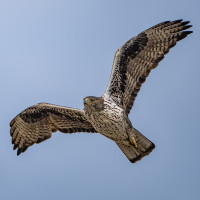Descripción
A long cycle route starts here but of more interest to birdwatchers is the convenient c4-5 km circular walk through pine woods to a ridge and back down to the main track. The woodlands hold Mosquitero Papialbo and Herrerillo Capuchino, open areas have Escribano Montesino, Escribano Soteño and Alondra Totovía and the low scrub a variety of ‘Sylvia’ warblers such as Curruca Zarcera, Curruca Cabecinegra and Curruca Rabilarga. As with all footpaths beside the A 381 this is a good location to look for raptors particularly in spring and autumn when Águila calzada, Milano Negro, Abejero Europeo and the odd Alimoche Común (plus Cigüeña Negra) pass through. Culebrera Europea (spring-autumn), Buitre Leonado , Gavilán Común and Busardo ratonero frequently appear but if you're lucky you may spot Águila perdicera or Azor Común here. During passage periods expect Abejaruco Europeo and pretty much any small passerine migrant.
Detalles
Accesso
Take Exit 66 off the A 381 and then the service road south for just under 2km and pull over on to a dirt track on your left to explore the signposted Sendero La Teja Park and follow the paths.
Terreno y habitat
Bosque , Árboles y arbustos dispersos , MontañaCondiciones
MontañosoCamino circular
Sí¿Se necesita telescopio?
NoBuena época para el avistamiento de aves
Primavera , OtoñoMejor momento para visitar
Migración de primavera , Primavera , Otoño , Migración de otoñoRuta
Camino sin asfaltar , Camino estrechoCamino difícil de andar
AgotadorAccesible vía
A pie , BicicletaEscondite de observación / plataforma
NoInformación extra
The tracks here provide a variety of 'pan handle' walks from 4 km upwards allowing you to tailor your walk to your individual requirements most of the walks are fairly easy but there are several steep sections. Look out for various orchid species and the local Portuguese Sundew (Drosophyllum lusitanicum) which, unlike sundews in northern Europe, has attractive pale yellow flower making it easy to locate.





